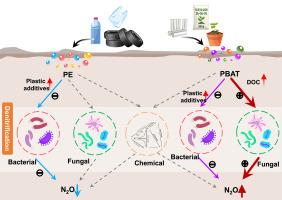Biodegradable microplastics increase fungi-mediated N2O emission by rapidly releasing dissolved organic matters
IF 5
2区 农林科学
Q1 SOIL SCIENCE
引用次数: 0
Abstract
Plastic pollution in paddy fields disrupts soil nitrogen biogeochemistry, prompting the introduction of biodegradable plastics like PBAT (poly (butylene adipate-co-terephthalate)) as a potential mitigation strategy to plastic pollution reduction. However, the effects of nonbiodegradable and biodegradable microplastics on the nitrogen cycle remain unclear. To clarify this, we conducted an incubation experiment, N2O isotopocules, and molecular analysis to assess the impact of additives from PBAT and non-biodegradable (polyethylene, PE) microplastics. This study aimed to investigate their effects on N2O emission from bacterial, fungal, and chemical denitrification. The results showed that PE reduced N2O production potential from denitrification (DN2O) and bacterial denitrification (BDN2O), while PBAT (poly (butylene adipate-co-terephthalate)) increased DN2O and fungal-derived N2O (FDN2O) but decreased BDN2O. PE inhibited N2O production via bacterial denitrification due to the toxicity of plastic additives such as dibutyl phthalate (DBP) and diethylhexyl phthalate (DEHP). In contrast, PBAT enhanced N2O production via fungal pathways by facilitating the release of dissolved organic carbon. Bacterial denitrification accounted for 43–56% of total N2O production potential (DN2O) in PE treatments but only 28–50% in PBAT treatments. These findings highlight the short-term risks posed by biodegradable microplastics in elevating N2O emissions and reveal new dimensions of the influence of microplastics on greenhouse gas emissions from agricultural soils.

可生物降解的微塑料通过快速释放溶解的有机物增加真菌介导的N2O排放
稻田中的塑料污染破坏了土壤氮的生物地球化学,促使引入PBAT(聚己二酸丁二酯-对苯二甲酸酯)等可生物降解塑料,作为减少塑料污染的潜在缓解战略。然而,不可生物降解和生物降解微塑料对氮循环的影响尚不清楚。为了澄清这一点,我们进行了培养实验、N2O同位素和分子分析,以评估PBAT和不可生物降解(聚乙烯、PE)微塑料添加剂的影响。本研究旨在探讨细菌、真菌和化学反硝化对N2O排放的影响。结果表明,PE降低了反硝化(DN2O)和细菌反硝化(BDN2O)产生N2O的潜力,而PBAT(聚己二酸丁二酯-对苯二甲酸酯)增加了DN2O和真菌源N2O (FDN2O),但降低了BDN2O。由于塑料添加剂如邻苯二甲酸二丁酯(DBP)和邻苯二甲酸二乙基己酯(DEHP)的毒性,PE通过细菌反硝化作用抑制了N2O的产生。相比之下,PBAT通过促进溶解有机碳的释放,通过真菌途径促进N2O的产生。细菌反硝化作用占PE处理总N2O生产潜力(DN2O)的43-56%,而PBAT处理仅占28-50%。这些发现突出了可生物降解微塑料在增加一氧化二氮排放方面带来的短期风险,并揭示了微塑料对农业土壤温室气体排放影响的新层面。
本文章由计算机程序翻译,如有差异,请以英文原文为准。
求助全文
约1分钟内获得全文
求助全文
来源期刊

Applied Soil Ecology
农林科学-土壤科学
CiteScore
9.70
自引率
4.20%
发文量
363
审稿时长
5.3 months
期刊介绍:
Applied Soil Ecology addresses the role of soil organisms and their interactions in relation to: sustainability and productivity, nutrient cycling and other soil processes, the maintenance of soil functions, the impact of human activities on soil ecosystems and bio(techno)logical control of soil-inhabiting pests, diseases and weeds.
 求助内容:
求助内容: 应助结果提醒方式:
应助结果提醒方式:


